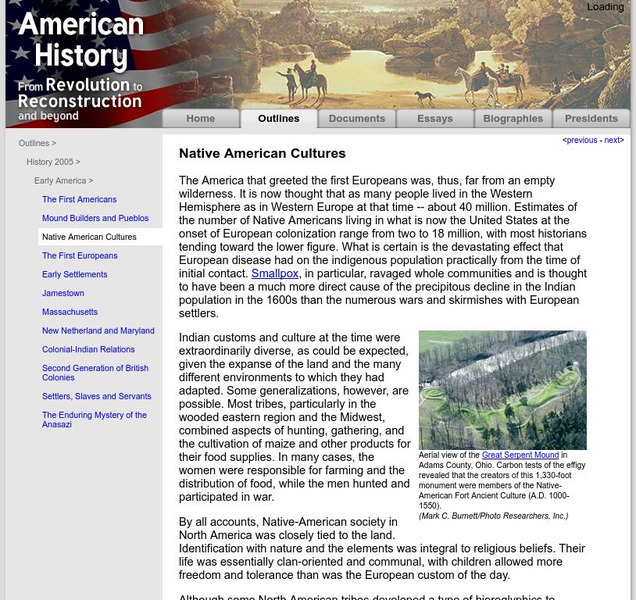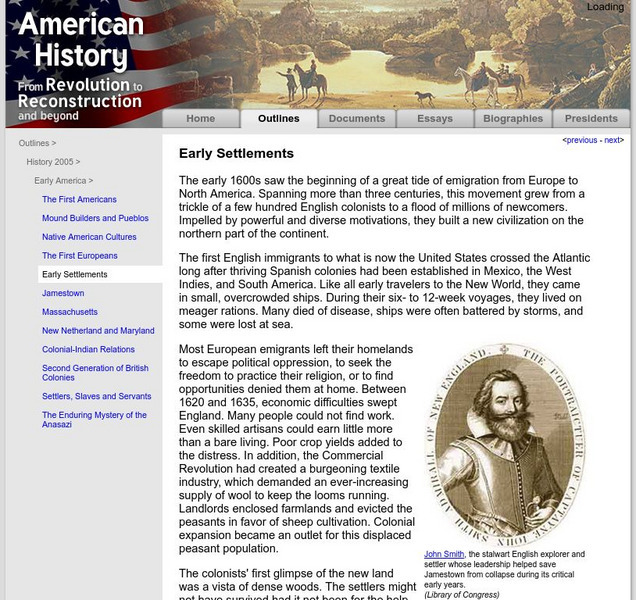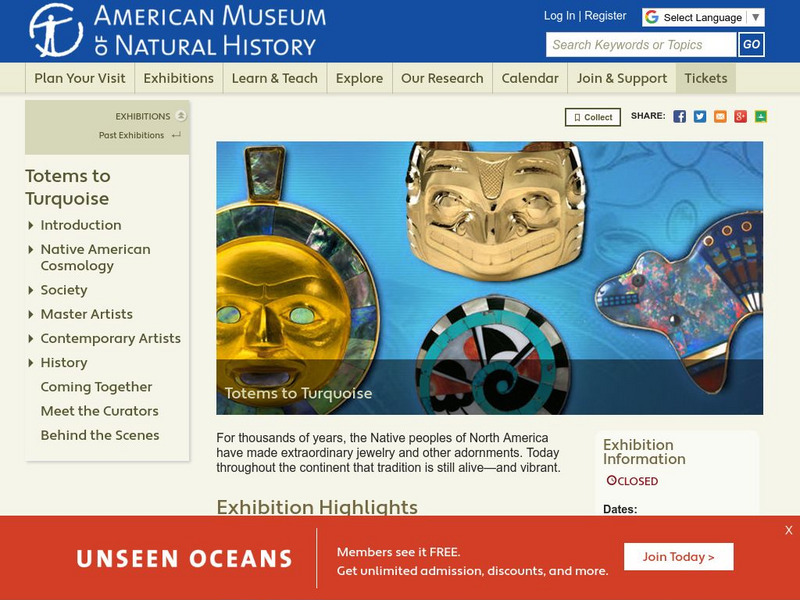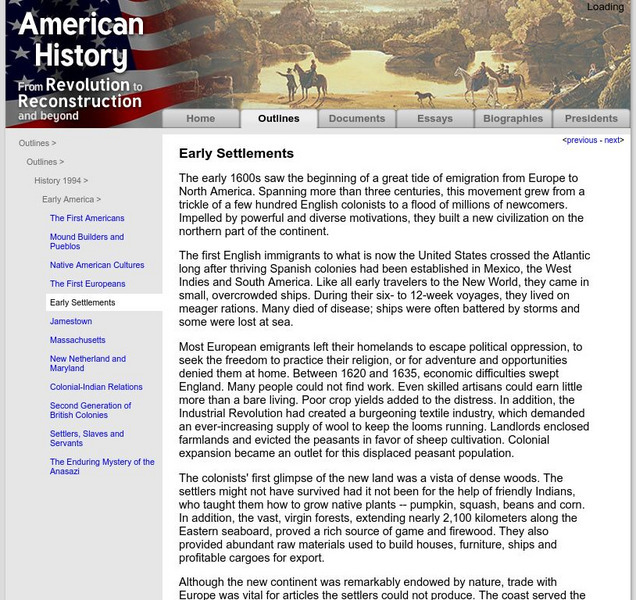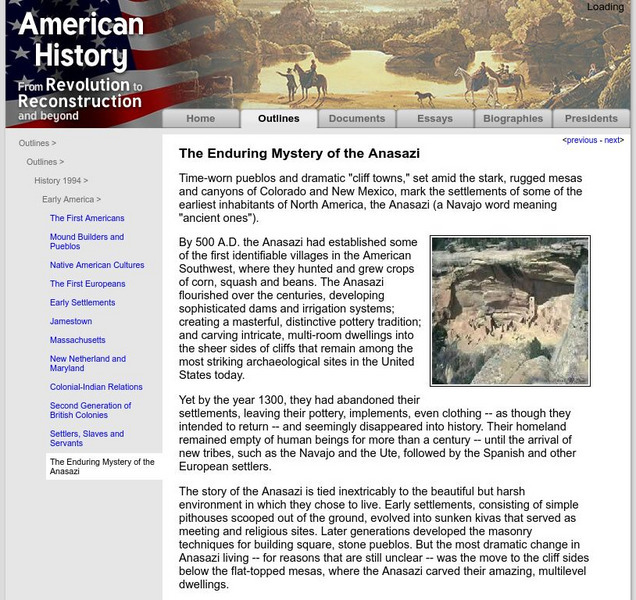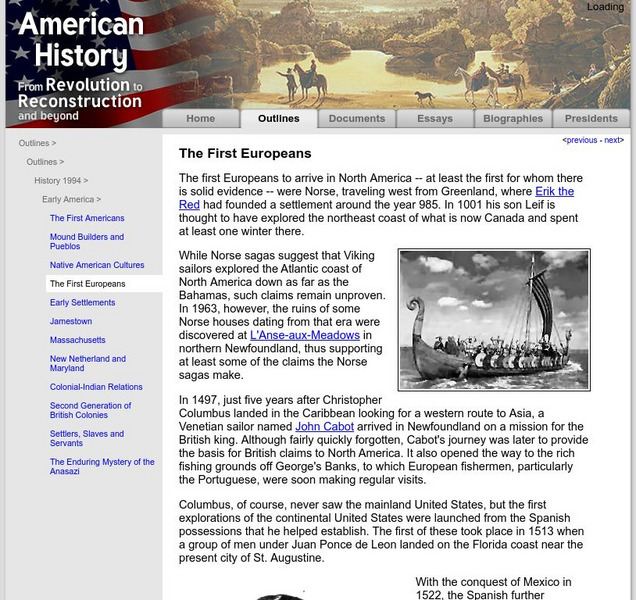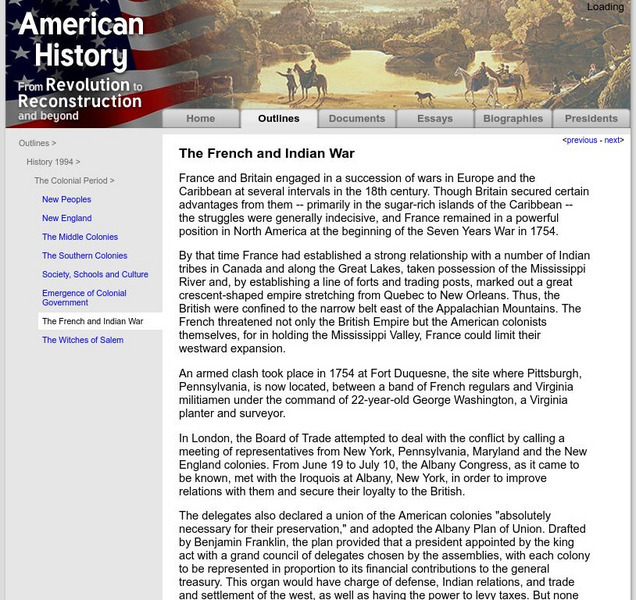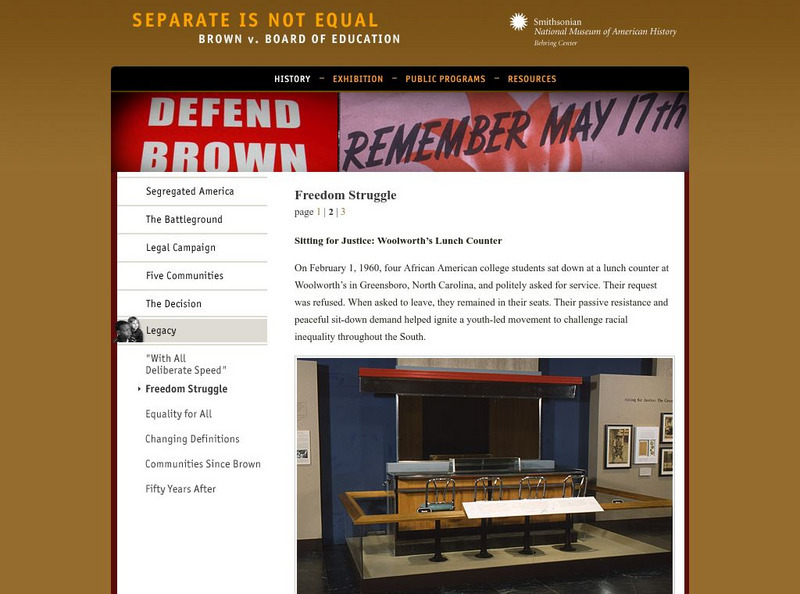University of Groningen
American History: Outlines: Native American Cultures
The America that greeted the first Europeans was, thus, far from an empty wilderness. It is now thought that as many people lived in the Western Hemisphere as in Western Europe at that time -- about 40 million. Estimates of the number of...
CommonLit
Common Lit: Text Sets: Native American History
This is a collection of 27 Grade-Leveled texts (4-12) on the topic Native American History. Before European settlers came to North America, millions of native people lived in many unique societies. Explore the history of Native Americans...
Smithsonian Institution
National Museum of Natural History: North American Mammals
The National Museum of Natural History provides users the opportunity to create personalized field guides of North American mammals based on a wide variety of search options.
University of Groningen
American History: Outlines: Early Settlements
The early 1600s saw the beginning of a great tide of emigration from Europe to North America. Spanning more than three centuries, this movement grew from a trickle of a few hundred English colonists to a flood of millions of newcomers....
University of Groningen
American History: Outlines: The Enduring Mystery of the Anasazi
Time-worn pueblos and dramatic cliff towns, set amid the stark, rugged mesas and canyons of Colorado and New Mexico, mark the settlements of some of the earliest inhabitants of North America, the Anasazi (a Navajo word meaning "ancient...
University of Groningen
American History: Outlines: The First Europeans
The first Europeans to arrive in North America -- at least the first for whom there is solid evidence -- were Norse, traveling west from Greenland, where Erik the Red had founded a settlement around the year 985. In 1001 his son Leif is...
University of Groningen
American History: Outlines: Jamestown
The first of the British colonies to take hold in North America was Jamestown. On the basis of a charter which King James I granted to the Virginia (or London) company, a group of about 100 men set out for the Chesapeake Bay in 1607....
University of Groningen
American History: Outlines: New Netherland and Maryland
Hired by the Dutch East India Company, Henry Hudson in 1609 explored the area around what is now New York City and the river that bears his name, to a point probably north of present-day Albany, New York. Subsequent Dutch voyages laid...
Library of Congress
Loc: Primary Documents in American History: Treaty of Ghent
This web page from the U.S. Library of Congress includes a brief bibliographic record and a link to a digital copy of the original. The Treaty of Ghent was negotiated in Belgium and it ended hostilities between the United States and...
University of Groningen
American History: Outlines: Panama and Nafta
Brief description of Panama and North American Free Trade Agreement (NAFTA) negotiated by President George Bush and ratified during the Clinton administration.
Henry J. Sage
Sage American History: American Economic Growth 1820 1860
Article outlines the boom in early American economic growth as a result of Northern industry in manufacturing, steam power, transportation and the role of government between 1820 and 1860.
Smithsonian Institution
National Museum of Natural History: The Hall of Arctic People
This is the online version of the Smithsonian Institute's exhibit devoted to the people of the Siberian and North American Arctic. The mannequins around the walls represent the peoples of the Crossroads region, dressed in traditional...
American Museum of Natural History
American Museum of Natural History: Totems to Turquoise: Native American Jewelry
Through this resource, the user can learn about the hand-crafted jewelry of Native North Americans of the Northwest and Southwest and how it embodies both the personal and collective identity of the maker and the wearer.
University of Groningen
American History: Biographies: Lord North (1713 1792)
Lord North was Prime Minister of Great Britain from January, 1770 to March, 1782. His early successes as Leader of the House and his efforts to cut the national debt brought him the confidence of a faction-ridden Parliament and the favor...
University of Groningen
American History: Outlines: Early Settlements
The early 1600s saw the beginning of a great tide of emigration from Europe to North America. Spanning more than three centuries, this movement grew from a trickle of a few hundred English colonists to a flood of millions of newcomers....
University of Groningen
American History: Outlines: The Enduring Mystery of the Anasazi
Time-worn pueblos and dramatic "cliff towns," set amid the stark, rugged mesas and canyons of Colorado and New Mexico, mark the settlements of some of the earliest inhabitants of North America, the Anasazi (a Navajo word meaning "ancient...
University of Groningen
American History: Outlines: The First Europeans
The first Europeans to arrive in North America -- at least the first for whom there is solid evidence -- were Norse, traveling west from Greenland, where Erik the Red had founded a settlement around the year 985. In 1001 his son Leif is...
University of Groningen
American History: Outlines: Colonial Economy
Whatever early colonial prosperity there was resulted from trapping and trading in furs. In addition, the fishing industry was a primary source of wealth in Massachusetts. But throughout the colonies, people relied primarily on small...
University of Groningen
American History: Outlines: Southern Colonies
In contrast to New England and the middle colonies were the predominantly rural southern settlements: Virginia, Maryland, North and South Carolina, and Georgia.
University of Groningen
American History: Outlines: The French and Indian War
France and Britain engaged in a succession of wars in Europe and the Caribbean at several intervals in the 18th century. Though Britain secured certain advantages from them -- primarily in the sugar-rich islands of the Caribbean -- the...
Smithsonian Institution
National Museum of American History: Separate Is Not Equal: Sitting for Justice: Woolworth's Lunch Counter
Read a brief description of the sit-in at the Woolworth lunch counter in Greensboro, North Carolina. This sit-in, passive and non-violent resistance to segregation laws, lasted for six months.
University of Groningen
American History: Biographies: William Blount 1749 1800
William Blount was the great-grandson of Thomas Blount, who came from England to Virginia soon after 1660 and settled on a North Carolina plantation. William, the eldest in a large family, was born in 1749 while his mother was visiting...
University of Groningen
American History: Biographies: William Richardson Davie 1756 1820
One of the eight delegates born outside of the thirteen colonies, Davie was born in Egremont, Cumberlandshire, England, on June 20, 1756. In 1763 Archibald Davie brought his son William to Waxhaw, SC, where the boy's maternal uncle,...
University of Groningen
American History: Biographies: Richard Dobbs Spaight, Sr. 1758 1802
Spaight was born at New Bern, NC of distinquished English-Irish parentage in 1758. When he was orphaned at 8 years of age, his guardians sent him to Ireland, where he obtained an excellent education. He apparently graduated from...
